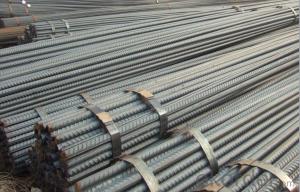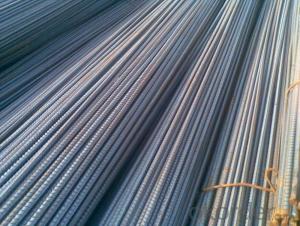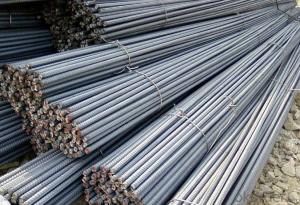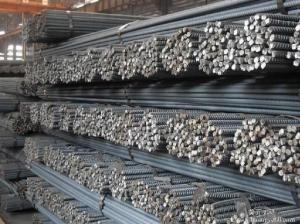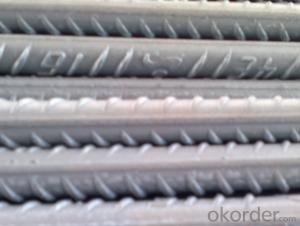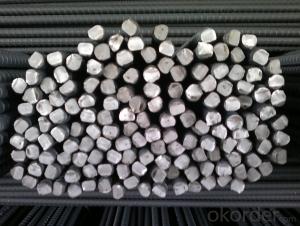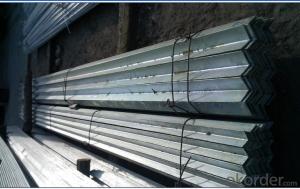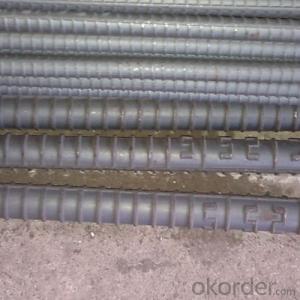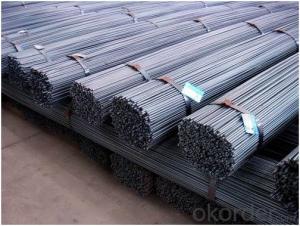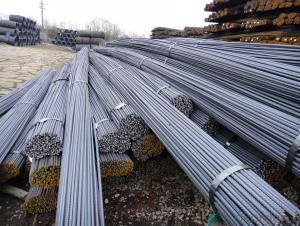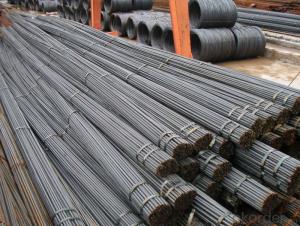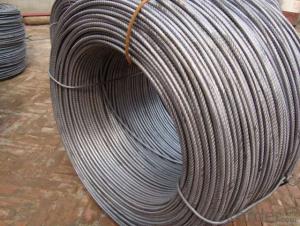High Quality Steel Deformed Bar HRB400 36/40/50mm
- Loading Port:
- Tianjin
- Payment Terms:
- TT or LC
- Min Order Qty:
- 100 m.t
- Supply Capability:
- 10000 m.t/month
OKorder Service Pledge
OKorder Financial Service
You Might Also Like
High Quality Steel Deformed Bar HRB400 36/40/50mm
Product Description:
Specifications of High Quality Steel Deformed Bar HRB400 36/40/50mm:
Standard | GB | HRB400 | |
Diameter | 36mm,40mm,50mm | ||
Length | 6M, 12M | ||
Place of origin | Hebei, China mainland | ||
Advantages | exact size, regular package, chemical and mechanical properties are stable. | ||
Type | Hot rolled deformed steel bar | ||
Chemical Composition of High Quality Steel Deformed Bar HRB400 36/40/50mm: (Please kindly find our chemistry of our material based on HRB400 as below for your information)
Grade | Technical data of the original chemical composition (%) | ||||||
C | Mn | Si | S | P | V | ||
HRB400 | ≤0.25 | ≤1.60 | ≤0.80 | ≤0.045 | ≤0.045 | 0.04-0.12 | |
Physical capability | |||||||
Yield Strength (N/cm²) | Tensile Strength (N/cm²) | Elongation (%) | |||||
≥400 | ≥570 | ≥14 | |||||
Theoretical weight and section area of High Quality Steel Deformed Bar HRB400 36/40/50mm as below for your information:
Diameter(mm) | Section area (mm²) | Mass(kg/m) | Weight of 12m bar(kg) |
36 | 1018 | 7.99 | 98.88 |
40 | 1257 | 9.87 | 118.44 |
50 | 1964 | 15.42 | 185.04 |
Usage and Applications of High Quality Steel Deformed Bar HRB400 36/40/50mm:
Deformed bar is widely used in buildings, bridges, roads and other engineering construction. Big to highways, railways, bridges, culverts, tunnels, public facilities such as flood control, dam, small to housing construction, beam, column, wall and the foundation of the plate, deformed bar is an integral structure material. With the development of world economy and the vigorous development of infrastructure construction, real estate, the demand for deformed bar will be larger and larger.
Packaging & Delivery of High Quality Steel Deformed Bar HRB400 36/40/50mm:
Packaging Detail: products are packed in bundle and then shipped by container or bulk vessel, deformed bar is usually naked strapping delivery, when storing, please pay attention to moisture proof. The performance of rust will produce adverse effect.
Each bundle weight: 2-3MT, or as required
Payment term: TT or L/C
Delivery Detail: within 45 days after received advanced payment or LC.
Label: to be specified by customer, generally, each bundle has 1-2 labels
Trade terms: FOB, CFR, CIF
FAQ:
Q1: Why buy Materials & Equipment from OKorder.com?
A1: All products offered byOKorder.com are carefully selected from China's most reliable manufacturing enterprises. Through its ISO certifications, OKorder.com adheres to the highest standards and a commitment to supply chain safety and customer satisfaction.
Q2: How do we guarantee the quality of our products?
A2: We have established an advanced quality management system which conducts strict quality tests at every step, from raw materials to the final product. At the same time, we provide extensive follow-up service assurances as required.
Q3: How soon can we receive the product after purchase?
A3: Within three days of placing an order, we will arrange production. The shipping date is dependent upon the quatity, how many sizes you want and the plan of production, but is typically 1 month to 2 month days from the beginning of production.
Images of High Quality Steel Deformed Bar HRB400 36/40/50mm:
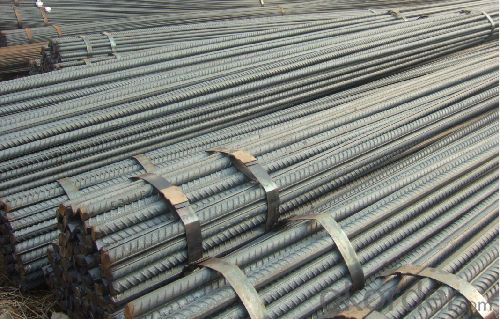
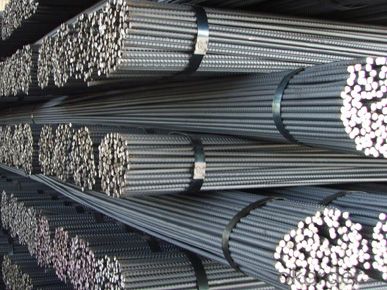
*If you would like to get our price, please inform us the size, standard/material and quantity. Thank you very much for your attention.
- Q: Can steel rebars be painted or coated for aesthetic purposes?
- Indeed, it is possible to paint or apply a coating to steel rebars in order to enhance their aesthetic appeal. By painting or coating these rebars, their appearance can be improved and they can be made to blend in harmoniously with the surrounding structures or environment. The choice of paint or coating can be made based on the desired color or style, enabling the rebars to seamlessly integrate into the overall design. Additionally, painting or coating the rebars can serve as a protective layer against corrosion, thereby prolonging their lifespan. However, it is crucial to bear in mind that the paint or coating used must be specifically formulated for steel and possess the ability to adhere firmly to the surface, guaranteeing both durability and longevity.
- Q: Two grade steel and three grade steel difference, the construction of the use of thread steel in general how to use the level?
- The difference is mainly in strength. The higher the grade, the greater the tensile strength.
- Q: What is the role of steel rebars in industrial chimney construction?
- Steel rebars play a crucial role in industrial chimney construction as they provide strength, stability, and durability to the structure. By reinforcing the concrete, rebars enhance the chimney's ability to withstand heavy loads, high temperatures, and harsh environmental conditions. They ensure the structural integrity of the chimney, preventing it from collapsing or cracking under stress. Furthermore, rebars help distribute forces evenly, reducing the risk of localized damage and ensuring the longevity of the chimney.
- Q: Can steel rebars be used in coastal areas?
- Yes, steel rebars can be used in coastal areas. However, it is important to consider the potential impact of corrosion due to the saltwater and high humidity present in these environments. To mitigate this risk, stainless steel rebars or epoxy-coated rebars can be used, as they offer better resistance to corrosion. These alternative options provide a protective layer that prevents the steel from coming into direct contact with the corrosive elements. Additionally, proper maintenance and periodic inspection of the rebars are crucial in coastal areas to ensure their long-term durability and structural integrity.
- Q: Can steel rebars be used in railway and transportation infrastructure?
- Yes, steel rebars can be used in railway and transportation infrastructure. Steel rebars, also known as reinforcing bars, are commonly used in the construction industry to provide strength and support to concrete structures. In railway and transportation infrastructure, where robust and durable structures are required, steel rebars are often used to reinforce concrete elements such as bridge piers, abutments, and retaining walls. The use of steel rebars in railway and transportation infrastructure offers several advantages. Firstly, steel rebars enhance the tensile strength of concrete, making the structures more resistant to the dynamic and heavy loads imposed by trains and vehicles. This is particularly important in bridges and elevated structures where the loads can be significant. Secondly, steel rebars provide structural integrity and prevent the development of cracks and deformations in the concrete. This is crucial for maintaining the long-term stability and safety of the infrastructure, especially considering the constant exposure to various environmental conditions, such as temperature variations and vibrations. Furthermore, steel rebars are highly durable and resistant to corrosion, which is essential in railway and transportation infrastructure that is often exposed to harsh weather conditions and chemical agents. Their ability to withstand these factors ensures the longevity of the structures and reduces the need for frequent repairs and maintenance. In conclusion, steel rebars can and are commonly used in railway and transportation infrastructure due to their ability to enhance the strength, durability, and stability of concrete structures. Their use ensures the safe and reliable operation of these vital transportation systems, providing a solid foundation for the efficient movement of people and goods.
- Q: How do steel rebars contribute to the overall ductility of a structure?
- Steel rebars contribute to the overall ductility of a structure by providing reinforcement and enhancing its ability to withstand deformations and absorb energy without failure. The addition of rebars in concrete structures improves its tensile strength, as concrete alone is weak in tension. This combination allows the structure to flex and bend under loading, reducing the risk of brittle failure and increasing its overall resilience.
- Q: What is the process of epoxy-coating steel rebars?
- The process of epoxy-coating steel rebars involves several steps to ensure a durable and corrosion-resistant coating. Here is an overview of the typical process: 1. Surface Preparation: The steel rebars are first cleaned thoroughly to remove any rust, oil, or other contaminants. This can be done using techniques such as sandblasting or chemical cleaning. 2. Priming: After cleaning, a primer is applied to the rebars. The primer helps to enhance adhesion between the steel surface and the epoxy coating. It also provides an additional layer of protection against corrosion. 3. Epoxy Coating Application: Once the primer has dried, the epoxy coating is applied to the rebars. This can be done using various methods, such as spray application or dipping the rebars into a tank of epoxy. 4. Curing: After the epoxy coating has been applied, the rebars are allowed to cure. This involves a controlled process where the coating is left to harden and fully bond with the steel surface. The curing time can vary depending on the specific epoxy used and environmental conditions. 5. Inspection: Once the rebars have cured, they undergo a thorough inspection to ensure that the epoxy coating is applied uniformly and meets the required specifications. This inspection may include visual checks, adhesion tests, and measurements of coating thickness. 6. Packaging and Storage: After passing the inspection, the epoxy-coated steel rebars are packaged and stored in a controlled environment to protect them from any damage or further contamination. It is important to note that the specific process may vary depending on the manufacturer, project requirements, and the type of epoxy coating being used. Additionally, it is crucial to follow industry standards and guidelines to ensure the quality and effectiveness of the epoxy-coated steel rebars.
- Q: Can steel rebars be used in water treatment facilities?
- Yes, steel rebars can be used in water treatment facilities. Steel rebars are commonly used in the construction of various structures, including water treatment facilities. They provide strength and durability to the concrete structures, ensuring their stability and longevity in the harsh environment of water treatment facilities.
- Q: Are there any limitations or restrictions on using steel rebars in construction?
- Steel rebars in construction have certain limitations and restrictions. Here are some of them: 1. Corrosion: Moisture and certain chemical environments can cause steel rebars to corrode, weakening them over time and compromising the structural integrity of the construction. To address this limitation, protective coatings or stainless steel rebars can be employed. 2. Fire Resistance: When exposed to high temperatures during a fire, steel rebars can lose strength and become malleable, leading to potential structural failure. Fireproof coatings or concrete encasement can enhance the fire resistance of steel rebars. 3. Weight: Large-scale construction projects may face challenges in transportation, handling, and installation due to the significant weight of steel rebars. Additional labor or equipment may be necessary, increasing project costs. 4. Thermal Expansion: Steel's high coefficient of thermal expansion causes it to expand and contract significantly with temperature changes. This can result in thermal stresses and concrete cracking around the rebars. Proper design techniques and the use of expansion joints can mitigate this limitation. 5. Electromagnetic Interference: Steel rebars can interfere with electromagnetic signals used in communication systems or sensitive electronic equipment, which is crucial to consider when constructing buildings with specific requirements, such as hospitals or laboratories. 6. Cost: The cost of steel rebars can fluctuate based on market conditions, availability, and quality, impacting the overall budget of construction projects, especially when large quantities are needed. It is important to acknowledge that despite these limitations, steel rebars are widely used in construction due to their strength, durability, and availability. Proper design, construction techniques, and maintenance can help overcome these limitations, ensuring the safe and efficient use of steel rebars in buildings and infrastructure.
- Q: How do steel rebars affect the overall maintenance requirements of concrete structures?
- Steel rebars play a crucial role in the overall maintenance requirements of concrete structures. These reinforcing bars are used to enhance the strength and durability of concrete by providing tensile strength and preventing cracks. By adding steel rebars to concrete, the structure becomes better equipped to resist the forces that it may encounter during its lifespan. One of the primary ways that steel rebars affect maintenance requirements is by reducing the likelihood of cracks in concrete structures. Concrete on its own is strong in compression but weak in tension. When subjected to tensile forces, such as loads or temperature fluctuations, concrete tends to crack. However, by incorporating steel rebars within the concrete, these cracks are minimized or prevented altogether. This is because the steel rebars absorb the tensile forces, allowing the concrete to remain intact and intact structures require less maintenance. Furthermore, steel rebars also increase the overall strength of concrete structures, making them more resistant to external forces. This added strength reduces the chances of structural failure, thereby decreasing the maintenance requirements in terms of repairs or replacements. Additionally, the use of steel rebars can extend the lifespan of concrete structures, as they provide the necessary reinforcement to withstand the test of time. However, it is essential to note that steel rebars can also be susceptible to corrosion over time, which can impact the maintenance requirements of concrete structures. When steel rebars corrode, they expand, causing cracks and spalling in the concrete. This corrosion can be accelerated by various factors such as exposure to moisture, chloride ions, or carbonation. Therefore, regular inspections and maintenance measures, such as protective coatings or cathodic protection, must be implemented to prevent or manage the corrosion of steel rebars. In conclusion, steel rebars have a significant impact on the overall maintenance requirements of concrete structures. They enhance the strength, durability, and resistance of concrete, reducing the occurrence of cracks and structural failures. However, proper maintenance and protection against corrosion are necessary to ensure the continued effectiveness of steel rebars, ultimately contributing to the longevity and low maintenance needs of concrete structures.
Send your message to us
High Quality Steel Deformed Bar HRB400 36/40/50mm
- Loading Port:
- Tianjin
- Payment Terms:
- TT or LC
- Min Order Qty:
- 100 m.t
- Supply Capability:
- 10000 m.t/month
OKorder Service Pledge
OKorder Financial Service
Similar products
Hot products
Hot Searches
Related keywords

